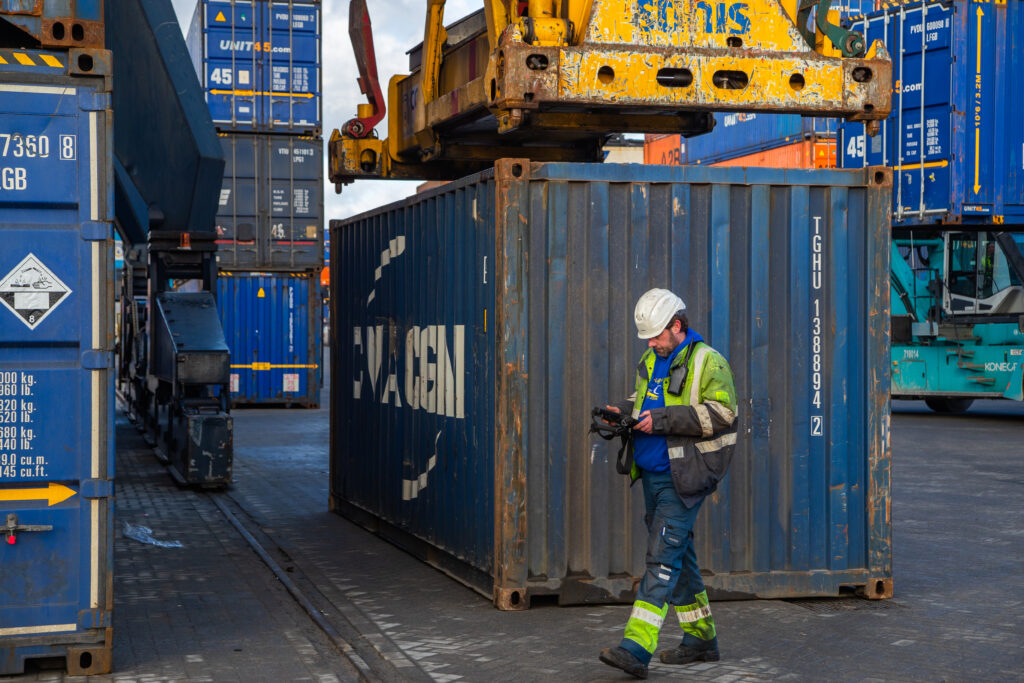
The linking of web modules to the central ICMS application is highly important for the extensive automation of inland terminals. The crucial role of web applications in the automation of the external operations was already highlighted in a previous interview with CTVrede. In this article, Peter van Veelen, General Manager at Combined Cargo Terminals (CCT), will explain the diversity of web applications that CCT has implemented. And, even more importantly, which advantages (and competitive edges) the use of web applications has provided.
Process optimisation through the use of web applications
Not only does CCT offer excellent storage and transhipment facilities for various modalities, but the terminal also serves as a strategic port of call for shortsea routes to and from destinations in Northern Europe, Southern Europe and the United Kingdom. Furthermore, it is working on the optimisation of the cargo flows from and to the port of Rotterdam in a partnership with Barge Terminal Tilburg (BTT) and Oosterhout Container Terminal (OCT). Various web applications have been developed and integrated to ensure that the numerous operational processes surrounding these services run as effectively as possible. The use of these web applications has resulted in the following benefits for CCT:
- More efficient operation
- Improved inspections
- Scalable processes
- Better and fast communication to the customer
- Improved insight into data of cargo flows
In the paragraphs below, we will explain which applications CCT has implemented and the added value that each individual application has provided.
Reach stacker web application
About five years ago, CCT started with the development of a reach stacker web application to replace the traditional wireless application that had already been in use for some time. This made it possible to replace the less user-friendly and somewhat cumbersome screens from the reach stackers with convenient tablets. Making use of the web application for this purpose enables employees in the external operation to properly perform inspections and take pictures of any irregularities and damage. The implementation of the reach stacker application was an important test for CCT.
Peter: “We assessed whether the project with the reach stacker web application was feasible and scalable. We quickly established that the implementation was successful and we saw the potential for other applications.”
The successful implementation of the reach stacker application provided CCT with solid insight into the possibilities and benefits that the optimisation of other processes could bring. Shortly thereafter, several web applications were developed and implemented.

Reach stacker web application CCT
Transport planning terminal trucks, stowage plan and quay planning
Following the implementation of the reach stacker web application, the transport planning and transport orders of the terminal trucks were migrated to a web application as well. This allowed for even more efficient planning and made it possible to communicate status information to the customer with increased speed and accuracy. Meanwhile, it has also become possible to gain insight into the stowage plans of the ships alongside the quay through a similar web application. The inspector is able to closely monitor the loading and unloading plan on a tablet and no longer needs to use paper lists. Not only does this substantially speed up the work, but it holds practical advantages as well, especially in bad weather. The most substantial benefit to date however is the development of a web application for quay planning. Thanks to this application, (work) planners have a real-time overview of the expected cargo and of which containers have already been loaded.
Peter: “The planning process has become much faster and the system is far less sensitive to errors (compared to the Excel overviews used in the past), but it is now also possible to work in the web environment with 30 people simultaneously.”
The office of CCT has been equipped with voyage monitors that display a current view of the quay planning. In addition to planning and work preparation, customer service and the drivers’ service desk also gladly make use of the current loading and unloading information.
Further optimisation logistics processes
CCT’s continuous drive to further optimise logistics processes has resulted in the replacement of regular tablets by professional, industrial variants. CCT has also switched from a Wi-Fi connection to the 4G network in order to increase the range even further, allowing for terminal trucks to be tracked when they leave the site as well. Currently, CCT and Modality are developing a digital stack overview. This stack planning must ensure that ‘job-driven’ operations become possible. For example, an employee on a reach stacker is currently still able to determine which activities they will perform in which order. In order to further boost efficiency, the system will be the determining factor for this in the future. Work is also in full swing on the development of a customer portal.
Peter: “We serve different types of customers. Our customers who are involved in intermodal transport, for example, have different data needs than the shortsea operators. Both types of customers will soon have their own portal containing their own data provision. This allows us to display customs status, loading and unloading lists or stocks.”
Benefits for your inland terminal
The development and integration of web applications therefore is a crucial step in the automation of inland terminals and in boosting their effectivity. Gaining more up-to-date insight into data, improving operations and processes and being able to execute them more swiftly, minimising error margins and the ability to provide customers with more accurate feedback are the main benefits of working with web applications. Would you like to know which options are available for your processes? Or do you need advice with determining the priorities and drawing up a roadmap? We will gladly think along with you! You can contact us directly via the button below.




